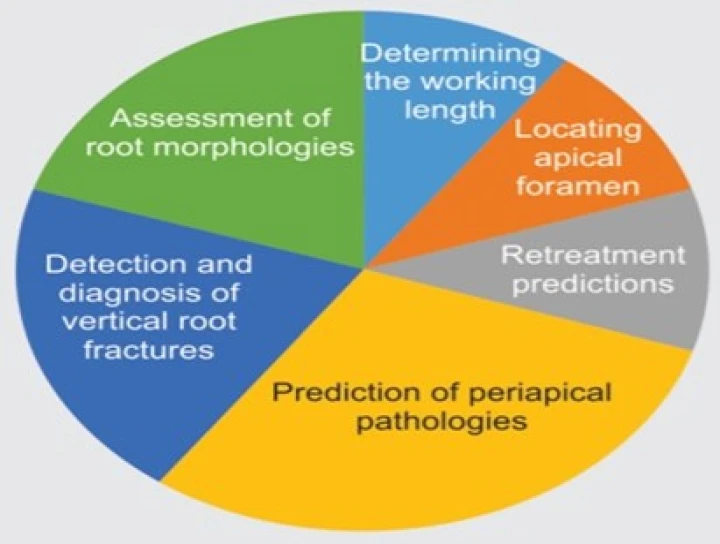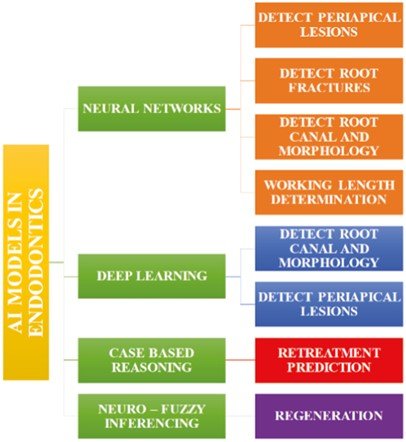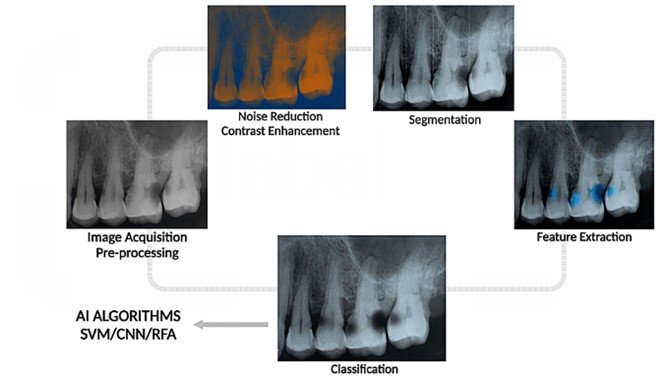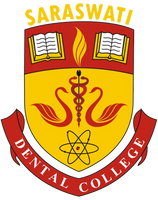
Artificial Intelligence is a simulation of human intelligence process by machines especially computer system. Renowned mathematician named John McCarthy proposed the word artificial intelligence and he is regarded as the father of artificial intelligence. Artificial intelligence has tremendous ability to make complex predictions and decision-making ability hence carving its way into dentistry particularly in the field of Endodontics.
AI includes subcategories like machine learning (ML) and related fields like deep learning (DL), advanced analytics, computational linguistics, automation, intelligent agents and probabilistic reasoning.
AI models like convolutional neural networks (CNN) and artificial neural networks (ANN) have been used in endodontics for locating apical foramen, working length determination, Root canal failure, detection of vertical root fractures, root morphology assessment, torque force detection during canal preparation, detection of pulpal disease, detection of periapical lesion and predicting post operative pain etc.

Application of AI in Endodontics:
· Caries Detection:
A computer-aided automated approach (ACDS) for the identification of occlusal caries lesions of posterior permanent teeth is used in accordance with the International Caries Detection and Assessment System (ICDAS II)

· Assessment of root morphology:
In order to recognize the distal root shape of the mandibular first molar on panoramic dental radiographs deep learning systems (Alex Net and Google Net) are used. Both deep learning algorithms performed diagnostic tasks better than radiologists with extensive training.
· Detection of periapical lesion:
Based on a random walk segmentation of a graph, a noninvasive differential diagnosis technique for periapical lesions and to pinpoint the precise position of periapical lesions and quantify their volume in CBCT images, a deep CNN-based AI diagnosis model was developed. By extracting relevant features from the matrix, a Random Forest (RF) method is used to classify the picture after segmentation, which results in the formation of a grey level cooccurrence matrix of the image. A super resolution generative adversarial network (SRGAN) is used as a way to generate high-resolution periapical images with a 4-order-of-magnitude improvement.
· Dental charting:
Deep convolutional neural network based automated system is used for classifying tooth types on dental cone-beam CT images and as a component of an automated dental chart filing system.
· Detecting Vertical root fracture:
The AI applications like ML, CNN, and PNN (probabilistic neural network) are used to detect the VRFs. The software used are DICOM 3 Visualization software, ROMEXIS, ACCUITOMO 3D, NEWTOM 3G, VISTASCAN PSP, CCD based detect net with DIGIT version 5, Pyramids Attention Convolutional Neural Network.
· Determining working Length and locating apical foramen:
ANN helps improve the diagnosis and results in better radiographic determination of working length it is also helpful as a judgement system.
· Retreatment Predictions:
The Case-based reasoning paradigm was used to predict nonsurgical endodontic retreatment outcomes and the benefits and risks.
Conclusion:
AI facilitates scientific investigations by incorporating in silico experimental research options into traditional research setups, supplementing other scientific degrees and existing modelling techniques.
The use of AI technologies to diagnose a periapical pathology from X-rays and CBCT diagnostic tests could aid clinicians in achieving identification precision that is comparable to, if not better than, specialists with good experience It may also decrease the dentist’s diagnostic time and effort by reducing evaluation time by allowing semiautomated documentation.
It is still important to do additional research
to test AI’s dependability, relevance and expenditure.


No Any Replies to “Artificial intelligence in Endodontics”
Leave a Reply